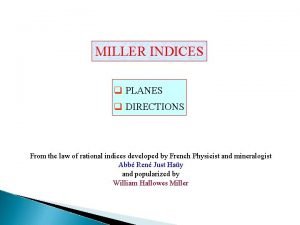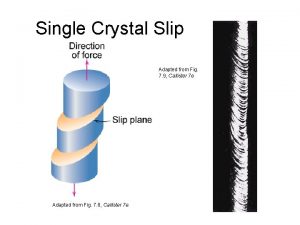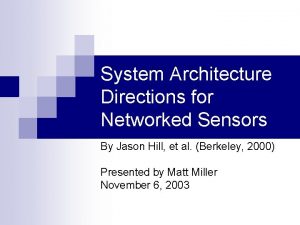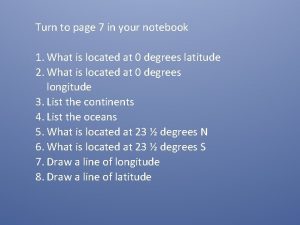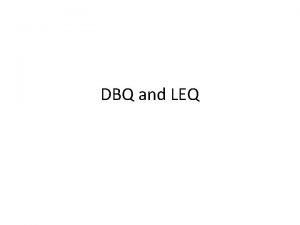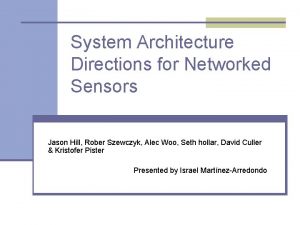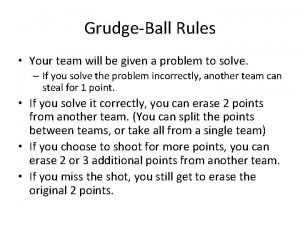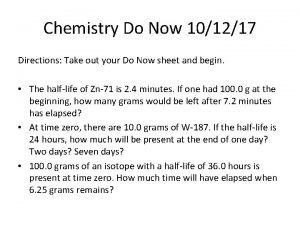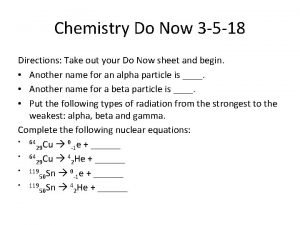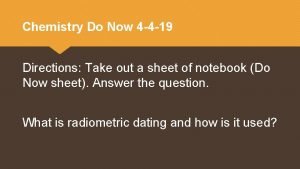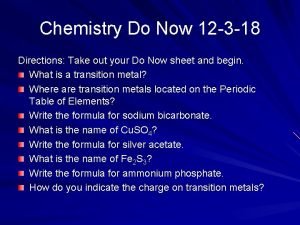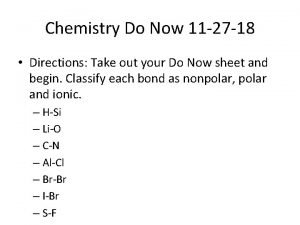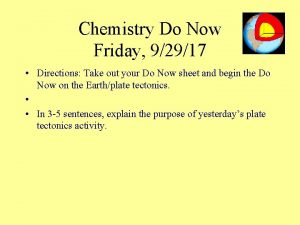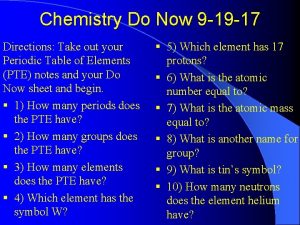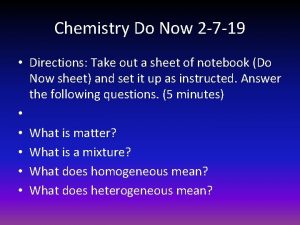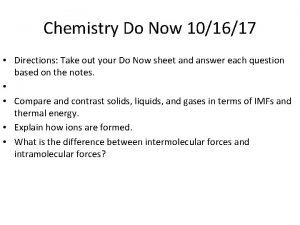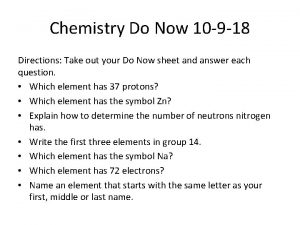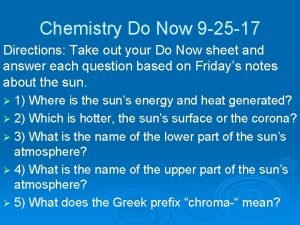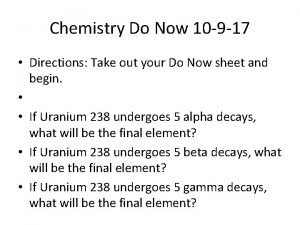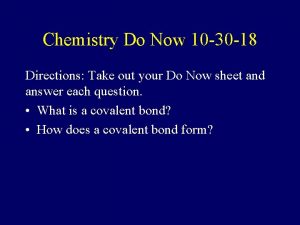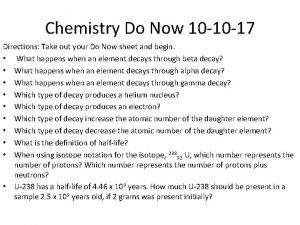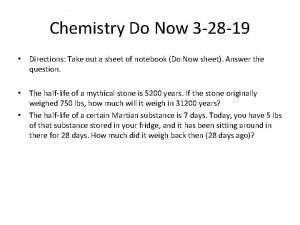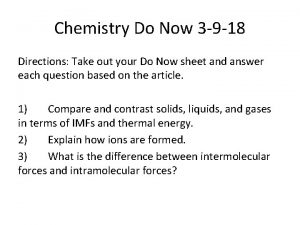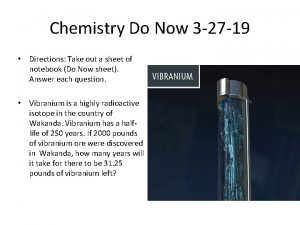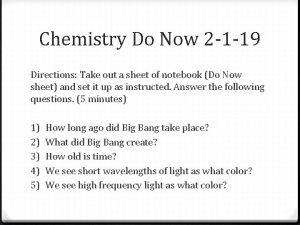Chemistry Do Now 2 5 19 Directions Take


































- Slides: 34

Chemistry Do Now 2 -5 -19 Directions: Take out a sheet of notebook (Do Now sheet) and set it up as instructed. Answer the following questions. (5 minutes) 0 0 How fast does light travel? 0 How far away is an object if it is 2 light years away? 0 What is a nebulae? 0 What typically form in nebula?

Chemistry Do Now 2 -5 -19 Key 0 How fast does light travel? 186, 000 miles per second/300, 000 kilometers per second 0 How far away is an object if it is 2 light years away? 5, 865, 696, 000 miles/year x 2 = 11, 731, 392, 000 miles away (almost 12 trillion miles away) 0 What is a nebulae? a cloud of gas and dust in outer space 0 What typically form in nebula? Stars and planets

Objectives 0 Students will know how the universe was formed by Big Bang by taking notes, watching a video, reading an article and recreate the expansion of the universe. 0 Mastery Level: 75% or better on the article’s TDQs, exit ticket and big bang activity

If you have your expectation letter signed and “Chemistry is Everywhere” Double Entry Journal, turn them in.

Unit 1 Vocabulary Words 0 Big Bang Theory 0 Redshift 0 Blueshift 0 Light 0 Wavelength 0 Matter 0 Hydrogen 0 Helium 0 Nuclear fusion 0 Cosmic Background Microwave Radiation 0 Galaxy 0 Gravity 0 Light Year 0 Milky Way 0 Nebula(e) 0 Photons 0 Star 0 Sun 0 Universe

Engage 0 Students will watch “How do Stars form? | #aumsum #kids #supernova #protostar #stars” 0 Source: https: //www. youtube. com/watch? v=yq 2 Fnh. CBH 2 U 0 Students will watch “Star's Planet-Forming Disc Revealed In Unprecedented Detail | Video 0 Source: https: //www. youtube. com/watch? v=aqt 7 s 0 J 10 f 8 0 Students will watch “Red Shift and Doppler Effect”. 0 Source: https: //www. youtube. com/watch? v=y 5 t. KC 3 n. Ex 2 I

Explore 0 Students will recreate the expansion of the universe 0 Source: file: ///I: /Chemistry%2020182019/Big%20 Bang%20 Activity%209 -20 -18. pdf

Prepare to take notes on the form ation of the univers e

THE LIGHT YEAR Light travels at 186, 000 miles per second (300, 000 kilometers per second). Therefore, a light second is 186, 000 miles (300, 000 kilometers). A light year is the distance that light can travel in a year, or: 186, 000 miles/second * 60 seconds/minute * 60 minutes/hour * 24 hours/day * 365 days/year = 5, 865, 696, 000 miles/year (almost 6 trillion miles) OR…… 1 LIGHT YEAR

• The universe began with a hot release of energy 13. 7 billion years ago called the Big Bang. The aftermath of the Big Bang consisted mostly of radiation, but as things cooled, the elements hydrogen and helium formed. • http: //imgsrc. hubblesite. or g/hu/explore_astronomy/s kywatch/db/307/audio/Sk y. Watch_307 -11252010. mp 3


• Big Bang Theory - Evidence for the Theory • First of all, we are reasonably certain that the universe had a beginning. • Second, galaxies appear to be moving away from us at speeds proportional to their distance. This is called "Hubble's Law. ” This observation supports the expansion of the universe and suggests that the universe was once universe compacted. • Third, if the universe was initially very, very hot as the Big Bang suggests, we should be able to find some remnant of this heat. In 1965, this was discovered a 2. 725 degree Kelvin (-454. 765 degree Fahrenheit, -270. 425 degree Celsius) Cosmic Microwave Background radiation (CMB) which pervades the observable universe. • Finally, the abundance of the "light elements" Hydrogen and Helium found in the observable universe are thought Helium to support the Big Bang model of origins.

What is a “nebula”? A cloud in space Made of gas and dust 0 Can have stars inside Most of the ones we see are inside our Milky Way Galaxy Different types Orion image at

The Solar Nebula Theory Basis of modern theory of planet formation. Planets form at the same time from the same cloud as the star. Planet formation sites observed today as dust disks of T Tauri stars. Sun and our solar system formed ~ 5 billion years ago.

0 a), (b) The solar nebula contracts and flattens into a spinning disk. The large blob in the center will become the Sun. Smaller blobs in the outer regions may become jovian planets (GAS GIANTS). 0 (c) Dust grains act as condensation nuclei, forming clumps of matter that collide, stick together, and grow into moon-sized planetesimals. 0 (d) Strong winds from the still-forming Sun expel the nebular gas. 0 (e) Planetesimals continue to collide and grow. 0 (f) Over the course of a hundred million years or so, planetesimals form a few large planets that travel in roughly circular orbits.

So… Big Bang & Solar Nebular? How are they related? 0 The Big Bang Theory considers the creation of all the matter and energy that exists in the universe. . Anywhere. . 0 The Solar Nebula theory uses that matter and energy, to create galaxies and solar systems.

What is a “galaxy”? A large group of stars outside of our own Milky Way Made of billions to trillions of stars 0 Also may have gas and dust Spiral, or elliptical, or irregular shaped Image at

Spiral galaxy--Andromeda NOAO/AURA/NSF Images at

Elliptical Galaxies Images at http: //hubblesite. org/newscenter/archive/releases/galaxy/elliptical/2007/08/image/

Irregular Galaxies NASA and NOAO/AURA/NSF Images at http: //hubblesite. org/newscenter/archive/releases/galaxy/irregular/2005/09/res

Our Galaxy: the Milky Way 0 has about 200 billion stars, and lots of gas and dust 0 is a barred-spiral (we think) 0 about 100, 000 light-years wide 0 our Sun is halfway to the edge, revolving at half a million miles per hour around the center of the Galaxy 0 takes our Solar System about 200 million years to revolve once around our galaxy

The Milky Way Image at

The Electromagnetic Spectrum

longest wavelength shortest wavelength The Electromagnetic Spectrum • The name given to a group of energy waves that are mostly invisible and can travel through empty space • Shorter waves have more energy and longer waves have less energy

longest wavelength shortest wavelength Characteristics of Radio waves: 1. Longest wavelength. 2. Transmit radio and TV signals.

longest wavelength shortest wavelength Characteristics of Microwaves: 1. Shorter than radio waves. 2. Absorbed by water molecules.

longest wavelength shortest wavelength Characteristics of Infrared waves: 1. Shorter wavelength than microwaves. 2. Felt as heat. 3. Hot objects give off infrared waves.

longest wavelength shortest wavelength Characteristics of Visible light: 1. Shorter wavelength than infrared waves. 2. Can be seen as colors. 3. Half of Sun’s rays are visible light.

longest wavelength shortest wavelength Characteristics of Ultraviolet light: 1. Shorter wavelength than visible light. 2. Give off harmful radiation. 3. Can kill living cells. 4. Causes skin cancer.

longest wavelength shortest wavelength Characteristics of X-ray radiation: 1. Shorter wavelength than ultraviolet. 2. Give off harmful radiation. 3. Pass through skin, not bone. 4. Harmful to humans.

longest wavelength shortest wavelength Characteristics of Gamma radiation: 1. Shortest wavelength (highest energy). 2. Comes from radioactivity or nuclear reactions. 3. Give off harmful radiation. 4. Harmful to humans.

REDSHIFT & BLUESHIFT

What Are Redshift and Blueshift? By Elizabeth Howell, Space. com Contributor | March 16, 2018 • The visible light spectrum. • Redshift and blueshift describe how light shifts toward shorter or longer wavelengths as objects in space (such as stars or galaxies) move closer or farther away from us. The concept is key to charting the universe's expansion. • Visible light is a spectrum of colors, which is clear to anyone who has looked at a rainbow. When an object moves away from us, the light is shifted to the red end of the spectrum, as its wavelengths get longer. If an object moves closer, the light moves to the blue end of the spectrum, as its wavelengths get shorter. • Source: https: //www. space. com/25732 -redshift-blueshift. html

Extension - Exit Ticket Questions: In 6 -9 sentences explain how our universe formed? Explain redshift and blueshift. • 8 -9 sentence explanation – 100% • 6 -7 – 80% • 4 -5 – 60% • < 4 sentences – 50%
 Now i see it now you don't
Now i see it now you don't Take a bus or take a train
Take a bus or take a train Ib organic chemistry functional groups
Ib organic chemistry functional groups Inorganic chemistry vs organic chemistry
Inorganic chemistry vs organic chemistry 100 family of planes
100 family of planes Staar test directions
Staar test directions What is dialogue
What is dialogue What directions do latitude lines run
What directions do latitude lines run New directions in cryptography
New directions in cryptography Slip in crystals
Slip in crystals Hse new directions
Hse new directions Carte de la belgique
Carte de la belgique System architecture directions for networked sensors
System architecture directions for networked sensors Dawn peek yearn hose
Dawn peek yearn hose Map reading vocabulary
Map reading vocabulary Multiple choice directions
Multiple choice directions Direction
Direction But these aren't cheap labour
But these aren't cheap labour Prime meridian map
Prime meridian map Directions
Directions Dorsal surface
Dorsal surface Tell me directions
Tell me directions Three parts of a recipe
Three parts of a recipe System architecture directions for networked sensors
System architecture directions for networked sensors Galataport directions
Galataport directions Grudge ball rules
Grudge ball rules Directions
Directions Medicine wheel colours meaning
Medicine wheel colours meaning Stage directions in a script
Stage directions in a script Fecal occult blood
Fecal occult blood Pulled in all directions
Pulled in all directions Direction part of speech
Direction part of speech Trashketball directions
Trashketball directions Organs in left lower quadrant
Organs in left lower quadrant Bright directions 529
Bright directions 529




